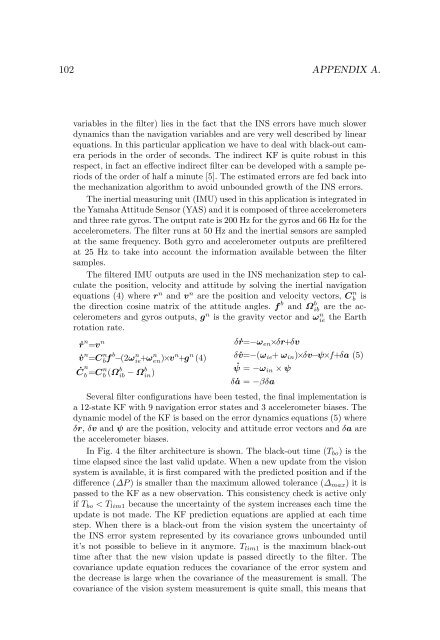Navigation Functionalities for an Autonomous UAV Helicopter
Navigation Functionalities for an Autonomous UAV Helicopter
Navigation Functionalities for an Autonomous UAV Helicopter
You also want an ePaper? Increase the reach of your titles
YUMPU automatically turns print PDFs into web optimized ePapers that Google loves.
102 APPENDIX A.<br />
variables in the filter) lies in the fact that the INS errors have much slower<br />
dynamics th<strong>an</strong> the navigation variables <strong>an</strong>d are very well described by linear<br />
equations. In this particular application we have to deal with black-out camera<br />
periods in the order of seconds. The indirect KF is quite robust in this<br />
respect, in fact <strong>an</strong> effective indirect filter c<strong>an</strong> be developed with a sample periods<br />
of the order of half a minute [5]. The estimated errors are fed back into<br />
the mech<strong>an</strong>ization algorithm to avoid unbounded growth of the INS errors.<br />
The inertial measuring unit (IMU) used in this application is integrated in<br />
the Yamaha Attitude Sensor (YAS) <strong>an</strong>d it is composed of three accelerometers<br />
<strong>an</strong>d three rate gyros. The output rate is 200 Hz <strong>for</strong> the gyros <strong>an</strong>d 66 Hz <strong>for</strong> the<br />
accelerometers. The filter runs at 50 Hz <strong>an</strong>d the inertial sensors are sampled<br />
at the same frequency. Both gyro <strong>an</strong>d accelerometer outputs are prefiltered<br />
at 25 Hz to take into account the in<strong>for</strong>mation available between the filter<br />
samples.<br />
The filtered IMU outputs are used in the INS mech<strong>an</strong>ization step to calculate<br />
the position, velocity <strong>an</strong>d attitude by solving the inertial navigation<br />
equations (4) where rn <strong>an</strong>d vn are the position <strong>an</strong>d velocity vectors, C n b is<br />
the direction cosine matrix of the attitude <strong>an</strong>gles. f b <strong>an</strong>d Ω b ib are the accelerometers<br />
<strong>an</strong>d gyros outputs, gn is the gravity vector <strong>an</strong>d ωn ie the Earth<br />
rotation rate.<br />
˙r n =v n<br />
˙v n =C n bf b −(2ω n ie+ω n en)×v n +g n (4)<br />
˙C n<br />
b =C n b (Ω b ib − Ω b in)<br />
δ ˙r=−ωen×δr+δv<br />
δ ˙v=−(ωie+ ωin)×δv−ψ×f+δa (5)<br />
˙ψ = −ωin × ψ<br />
δ ˙a = −βδa<br />
Several filter configurations have been tested, the final implementation is<br />
a 12-state KF with 9 navigation error states <strong>an</strong>d 3 accelerometer biases. The<br />
dynamic model of the KF is based on the error dynamics equations (5) where<br />
δr, δv <strong>an</strong>d ψ are the position, velocity <strong>an</strong>d attitude error vectors <strong>an</strong>d δa are<br />
the accelerometer biases.<br />
In Fig. 4 the filter architecture is shown. The black-out time (Tbo) is the<br />
time elapsed since the last valid update. When a new update from the vision<br />
system is available, it is first compared with the predicted position <strong>an</strong>d if the<br />
difference (∆P ) is smaller th<strong>an</strong> the maximum allowed toler<strong>an</strong>ce (∆max) it is<br />
passed to the KF as a new observation. This consistency check is active only<br />
if Tbo < Tlim1 because the uncertainty of the system increases each time the<br />
update is not made. The KF prediction equations are applied at each time<br />
step. When there is a black-out from the vision system the uncertainty of<br />
the INS error system represented by its covari<strong>an</strong>ce grows unbounded until<br />
it’s not possible to believe in it <strong>an</strong>ymore. Tlim1 is the maximum black-out<br />
time after that the new vision update is passed directly to the filter. The<br />
covari<strong>an</strong>ce update equation reduces the covari<strong>an</strong>ce of the error system <strong>an</strong>d<br />
the decrease is large when the covari<strong>an</strong>ce of the measurement is small. The<br />
covari<strong>an</strong>ce of the vision system measurement is quite small, this me<strong>an</strong>s that

















